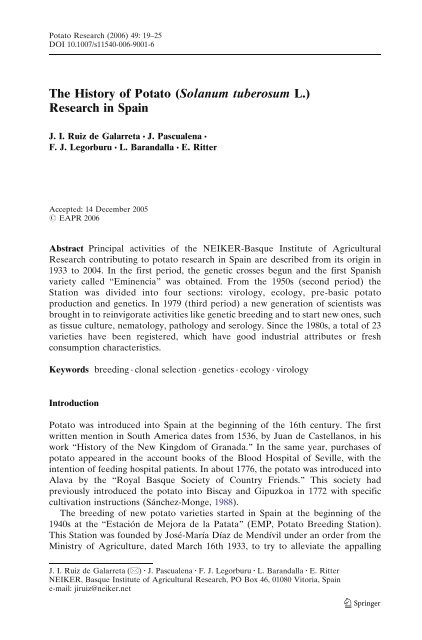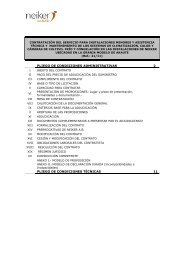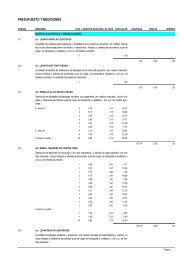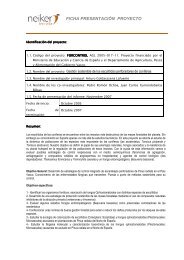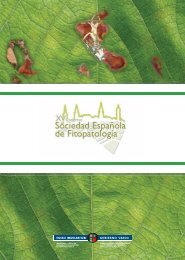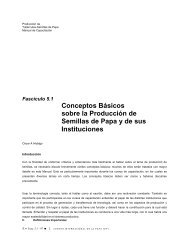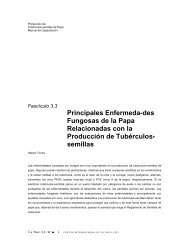The History of Potato (Solanum tuberosum L.) Research in ... - Neiker
The History of Potato (Solanum tuberosum L.) Research in ... - Neiker
The History of Potato (Solanum tuberosum L.) Research in ... - Neiker
Create successful ePaper yourself
Turn your PDF publications into a flip-book with our unique Google optimized e-Paper software.
<strong>Potato</strong> <strong>Research</strong> (2006) 49: 19–25<br />
DOI 10.1007/s11540-006-9001-6<br />
<strong>The</strong> <strong>History</strong> <strong>of</strong> <strong>Potato</strong> (<strong>Solanum</strong> <strong>tuberosum</strong> L.)<br />
<strong>Research</strong> <strong>in</strong> Spa<strong>in</strong><br />
J. I. Ruiz de Galarreta & J. Pascualena &<br />
F. J. Legorburu & L. Barandalla & E. Ritter<br />
Accepted: 14 December 2005<br />
# EAPR 2006<br />
Abstract Pr<strong>in</strong>cipal activities <strong>of</strong> the NEIKER-Basque Institute <strong>of</strong> Agricultural<br />
<strong>Research</strong> contribut<strong>in</strong>g to potato research <strong>in</strong> Spa<strong>in</strong> are described from its orig<strong>in</strong> <strong>in</strong><br />
1933 to 2004. In the first period, the genetic crosses begun and the first Spanish<br />
variety called BEm<strong>in</strong>encia^ was obta<strong>in</strong>ed. From the 1950s (second period) the<br />
Station was divided <strong>in</strong>to four sections: virology, ecology, pre-basic potato<br />
production and genetics. In 1979 (third period) a new generation <strong>of</strong> scientists was<br />
brought <strong>in</strong> to re<strong>in</strong>vigorate activities like genetic breed<strong>in</strong>g and to start new ones, such<br />
as tissue culture, nematology, pathology and serology. S<strong>in</strong>ce the 1980s, a total <strong>of</strong> 23<br />
varieties have been registered, which have good <strong>in</strong>dustrial attributes or fresh<br />
consumption characteristics.<br />
Keywords breed<strong>in</strong>g . clonal selection . genetics . ecology . virology<br />
Introduction<br />
<strong>Potato</strong> was <strong>in</strong>troduced <strong>in</strong>to Spa<strong>in</strong> at the beg<strong>in</strong>n<strong>in</strong>g <strong>of</strong> the 16th century. <strong>The</strong> first<br />
written mention <strong>in</strong> South America dates from 1536, by Juan de Castellanos, <strong>in</strong> his<br />
work B<strong>History</strong> <strong>of</strong> the New K<strong>in</strong>gdom <strong>of</strong> Granada.^ In the same year, purchases <strong>of</strong><br />
potato appeared <strong>in</strong> the account books <strong>of</strong> the Blood Hospital <strong>of</strong> Seville, with the<br />
<strong>in</strong>tention <strong>of</strong> feed<strong>in</strong>g hospital patients. In about 1776, the potato was <strong>in</strong>troduced <strong>in</strong>to<br />
Alava by the BRoyal Basque Society <strong>of</strong> Country Friends.^ This society had<br />
previously <strong>in</strong>troduced the potato <strong>in</strong>to Biscay and Gipuzkoa <strong>in</strong> 1772 with specific<br />
cultivation <strong>in</strong>structions (Sánchez-Monge, 1988).<br />
<strong>The</strong> breed<strong>in</strong>g <strong>of</strong> new potato varieties started <strong>in</strong> Spa<strong>in</strong> at the beg<strong>in</strong>n<strong>in</strong>g <strong>of</strong> the<br />
1940s at the BEstación de Mejora de la Patata^ (EMP, <strong>Potato</strong> Breed<strong>in</strong>g Station).<br />
This Station was founded by José-María Díaz de Mendívil under an order from the<br />
M<strong>in</strong>istry <strong>of</strong> Agriculture, dated March 16th 1933, to try to alleviate the appall<strong>in</strong>g<br />
J. I. Ruiz de Galarreta (*) : J. Pascualena : F. J. Legorburu : L. Barandalla : E. Ritter<br />
NEIKER, Basque Institute <strong>of</strong> Agricultural <strong>Research</strong>, PO Box 46, 01080 Vitoria, Spa<strong>in</strong><br />
e-mail: jiruiz@neiker.net
20 <strong>Potato</strong> <strong>Research</strong> (2006) 49: 19–25<br />
situation the crop was <strong>in</strong> at that time, with low-yield<strong>in</strong>g, degenerate varieties,<br />
chronically <strong>in</strong>fected by viruses. <strong>The</strong> Station was a part <strong>of</strong> the BInstituto Nacional de<br />
Investigaciones Agronómicas^ (INIA, National Institute <strong>of</strong> Agronomic <strong>Research</strong>).<br />
Dur<strong>in</strong>g the early years, the work was ma<strong>in</strong>ly done at the Iturrieta farm, situated <strong>in</strong><br />
the mounta<strong>in</strong>s, at an altitude <strong>of</strong> 990 m. It was here where the regeneration and<br />
multiplication <strong>of</strong> Spanish varieties, the organisation <strong>of</strong> seed potato production and<br />
the importation <strong>of</strong> varieties from different European countries and studies on their<br />
adaptation started. Dur<strong>in</strong>g the next two decades, the first research on genetic<br />
breed<strong>in</strong>g was carried out and focused on four ma<strong>in</strong> selection criteria: yield, drought<br />
resistance, early maturity and frost resistance.<br />
First Period (1933–1950)<br />
In 1933, the regeneration and multiplication <strong>of</strong> Spanish varieties cultivated at that<br />
time started us<strong>in</strong>g apparently healthy material, with the objectives: high yield,<br />
drought resistance, early maturity and frost resistance. However, little success was<br />
achieved and the work was abandoned after only a few years, as the desired<br />
characteristics could not be identified among local varieties.<br />
At the same time, a seed potato production system was organised us<strong>in</strong>g clonal<br />
selection. <strong>The</strong> EMP produced certificated potato seed until 1941 when the BNational<br />
Seed <strong>Potato</strong> Service^ was segregated from it. <strong>The</strong> clonal selection cont<strong>in</strong>ued at EMP<br />
<strong>in</strong> order to obta<strong>in</strong> prebasic and basic material.<br />
Dur<strong>in</strong>g this time about 40 cultivars from <strong>The</strong> Netherlands, Germany, United<br />
K<strong>in</strong>gdom and USA were imported, and adaptation studies were carried out<br />
(Zubeldia and López-Campos, 1954; Ubillos, 1960). From <strong>The</strong> Netherlands the<br />
varieties Saskia and Robijn (Basabe) were studied. From Germany the cultivars,<br />
Allerfrüheste Gelbe (Palogán), Erntedank, Oberarnbacher Frühe (Santa Lucia),<br />
Ackersegen (Sergen) and Merkur (Alava) were imported and adapted and the<br />
variety Katahd<strong>in</strong> from the USA.<br />
Subsequently, and because <strong>of</strong> the Spanish civil war (1936–1939), the contribution<br />
<strong>of</strong> new national and foreign varieties stopped, until 1941 when new cultivars were<br />
imported from Germany. In this first period, genetic cross<strong>in</strong>g began and the first<br />
Spanish variety called BEm<strong>in</strong>encia^ was obta<strong>in</strong>ed, a high yield<strong>in</strong>g, early matur<strong>in</strong>g<br />
cultivar, which is now lost.<br />
Second Period (1950–1979)<br />
In the 1950s, the EMP cont<strong>in</strong>ued work<strong>in</strong>g at the Iturrieta farm to produce prebasic<br />
potato, while the rest <strong>of</strong> the activities were moved to the BGranja Modelo^ (Model<br />
Farm) situated <strong>in</strong> Arkaute, near Vitoria-Gasteiz (Alava), on a high pla<strong>in</strong> (the<br />
Llanada Alavesa) at 600 m altitude. In this second period, under the directorship <strong>of</strong><br />
Miguel Odriozola, the work was diversified and specialised, and the Station was<br />
divided <strong>in</strong>to four sections (Sánchez-Monge, 1988):<br />
– Virology, where the susceptibility <strong>of</strong> the varieties was studied, as well as<br />
symptomatology, transmission <strong>of</strong> the ma<strong>in</strong> viruses and detection techniques<br />
such as the callose test to detect the <strong>Potato</strong> leaf roll virus (PLRV) <strong>in</strong> the tuber.
<strong>Potato</strong> <strong>Research</strong> (2006) 49: 19–25 21<br />
This work was presented at the Third Conference on <strong>Potato</strong> Virus Diseases <strong>in</strong><br />
Lisse-Wagen<strong>in</strong>gen (Rodríguez-Sardiña et al., 1957), a precursor <strong>of</strong> the EAPR<br />
Virology Section.<br />
– Ecology, to study the adaptation <strong>of</strong> the varieties to local conditions, and<br />
agronomic studies. (Odriozola, 1954; Escribano, 1955, 1958, 1960).<br />
– Prebasic and basic potato production.<br />
– Genetics, <strong>in</strong>clud<strong>in</strong>g the cytogenetic study <strong>of</strong> different species with<strong>in</strong> the genus<br />
<strong>Solanum</strong> (Sañudo, 1960, 1963), and the characterisation <strong>of</strong> old cultivated<br />
varieties with a view to their possible use <strong>in</strong> genetic breed<strong>in</strong>g. <strong>The</strong> germplasm<br />
conservation and its study and selection were carried out by D. José Buesa,<br />
especially over the period 1949–1954 (Buesa, 1963).<br />
<strong>The</strong> evaluation <strong>of</strong> newly <strong>in</strong>troduced foreign varieties cont<strong>in</strong>ued, which demonstrated<br />
that many <strong>of</strong> them were satisfactory with regard to yield and health status.<br />
However, most fared poorly <strong>in</strong> two important traits: cook<strong>in</strong>g quality and adaptation.<br />
<strong>The</strong>se qualities were present <strong>in</strong> old varieties, <strong>in</strong>troduced much earlier and practically<br />
nationalised, which could be utilised as parents (López-Campos and Zubeldia,<br />
1958). All this had led Díaz de Mendívil to consider new varieties try<strong>in</strong>g to comb<strong>in</strong>e<br />
the advantages <strong>of</strong> the old ones with those <strong>of</strong> the recently <strong>in</strong>troduced. By 1943,<br />
Ubillos had started a large cross<strong>in</strong>g programme select<strong>in</strong>g five varieties, which were<br />
submitted to the National Registry <strong>of</strong> Commercial Varieties <strong>in</strong> 1957, with the names<br />
Victor, Goya, Olalla, Turia and Duquesa (Table 1).<br />
<strong>The</strong> objectives <strong>of</strong> the Genetic Breed<strong>in</strong>g Programme were reassessed around this<br />
time (Odriozola, 1955), look<strong>in</strong>g for early maturity (Zubeldia, 1955), drought<br />
tolerance and frost tolerance. In the latter case, wild species like S. acaule, S.<br />
demissum, S. toralapanum, S. simplicifolium and S. andigena were used as parents <strong>in</strong><br />
the cross<strong>in</strong>g programme (Blanco and Ubeda, 1966). For drought tolerance Lopez-<br />
Campos (1955, 1956) utilised other wild species, like S. stenotonum. As a result <strong>of</strong><br />
this research that began <strong>in</strong> 1957 <strong>in</strong> cooperation with the BValencia Horticulture<br />
Station^ <strong>in</strong> order to obta<strong>in</strong> two harvests <strong>in</strong> a year (Lopez-Campos, 1959) and<br />
follow<strong>in</strong>g the new objectives, three new varieties were submitted to the Registry<br />
(Zubeldia, 1967). Two <strong>of</strong> the new varieties, Lora (Saskia Kathad<strong>in</strong>) and Aurea<br />
(later Gauna; Erntedank Kathad<strong>in</strong>), belonged to the early maturity selection<br />
programme, while India (Sergen Kathad<strong>in</strong>) came from the drought tolerance<br />
programme. <strong>The</strong>se new varieties were added to the seed potato certification scheme<br />
<strong>in</strong> 1966 (Fig. 1).<br />
In the follow<strong>in</strong>g years the varieties shown <strong>in</strong> Table 2, developed from these<br />
programmes, were selected and registered.<br />
Table 1 Varieties registered <strong>in</strong> Spa<strong>in</strong> <strong>in</strong> 1957.<br />
Variety<br />
Duquesa<br />
Goya<br />
Olalla<br />
Turia<br />
Victor<br />
Cross<br />
Blanca Temprana Katahd<strong>in</strong> (Erdgold)<br />
Blanca de Cernegula Flava<br />
Merkur Pedro Muñoz<br />
Blanca de Cernérgula Dolkowski’s Reg<strong>in</strong>a<br />
Robijn Industrie
22 <strong>Potato</strong> <strong>Research</strong> (2006) 49: 19–25<br />
CLONAL SELECTION<br />
PREHEADS<br />
TESTED TUBER<br />
G-2<br />
G-3<br />
PREBASE<br />
G-4<br />
G-5<br />
G-6<br />
G-7<br />
BASE<br />
SUPERELITE<br />
ELITE<br />
CERTIFIED “A”<br />
CERTIFIED<br />
CERTIFIED “A”<br />
CERTIFIED “B”<br />
Figure 1 <strong>The</strong> first seed potato certification scheme <strong>in</strong> 1966.<br />
Dur<strong>in</strong>g this period, a selection method for earl<strong>in</strong>ess <strong>in</strong> seedl<strong>in</strong>gs was developed<br />
(Zubeldia, 1963). This allowed a first selection to elim<strong>in</strong>ate the late clones at the<br />
seedbed stage. This researcher (Zubeldia) attended the 1st EAPR Conference <strong>in</strong><br />
Braunschweig-Völkenrode.<br />
Table 2 Varieties registered <strong>in</strong> Spa<strong>in</strong> between 1958 and 1979.<br />
Variety<br />
Lora<br />
Aurea (Gauna)<br />
India<br />
Alda<br />
Belda<br />
Buesa<br />
Iturrieta<br />
Zubeldia<br />
Diba<br />
Fenix<br />
Onda<br />
Cross<br />
Saskia Kathad<strong>in</strong><br />
Erntedank Kathad<strong>in</strong><br />
Sergen Kathad<strong>in</strong><br />
Erntedank Kathad<strong>in</strong><br />
Palogán (Allerfrüheste Gelbe) Kathad<strong>in</strong><br />
Palogán (Allerfrüheste Gelbe) Kathad<strong>in</strong><br />
Palogán (Allerfrüheste Gelbe) Kathad<strong>in</strong><br />
Erntedank Katahd<strong>in</strong><br />
Palogán (Allerfrüheste Gelbe) Kathad<strong>in</strong><br />
Palogán (Allerfrüheste Gelbe) Kathad<strong>in</strong><br />
Palogán (Allerfrüheste Gelbe) Kathad<strong>in</strong>
<strong>Potato</strong> <strong>Research</strong> (2006) 49: 19–25 23<br />
Table 3 Varieties registered <strong>in</strong> Spa<strong>in</strong> between 1979 and 2003.<br />
Variety<br />
Cross<br />
Arene<br />
Desirée Baraka<br />
Asun<br />
Kennebec Palogán (Allerfrüheste Gelbe)<br />
Ayala<br />
Alda Zubeldia<br />
Edurne<br />
LT-1 Buesa<br />
Gorbea<br />
V2 Asun<br />
Idoia<br />
Serrana Gloria<br />
Iker<br />
Alda Blanka<br />
Inca<br />
Spunta Aracy<br />
Isla<br />
Spunta Aracy<br />
Mayka<br />
Avenir AN66-42<br />
Mikel<br />
Palogán (Allerfrüheste Gelbe) Kathad<strong>in</strong><br />
Montico<br />
Alda Rosalie<br />
Nagore<br />
Desirée Baraka<br />
Nerea<br />
Kennebec Baraka<br />
Zadorra Onda 81035/02<br />
Zar<strong>in</strong>a<br />
CIP 324/04 Cascade<br />
Zela<br />
Fanal HT-2<br />
Zepa<br />
CIP 324/04 Cascade<br />
Zorba<br />
CIP 312/35 Carola<br />
Zunta<br />
Palogán (Allerfrüheste Gelbe) Erdgold<br />
In the 1960s epidemiological work was carried out on PLRV transmission (Pérez<br />
de San Román, 1963) and some North American varieties were freed from PVX and<br />
PVS by comb<strong>in</strong><strong>in</strong>g thermotherapy and meristem culture (García-Orad and Pérez de<br />
San Román, 1971), under a collaborative agreement with the USDA. For several<br />
reasons, work related to genetics and ecology was gradually abandoned at the EMP,<br />
and <strong>in</strong> the 1970s only the virology and basic seed sections rema<strong>in</strong>ed.<br />
Third Period (1979–2004)<br />
In 1979, Spanish agricultural research was regionalised and the Basque Government<br />
took over the Station. A new generation <strong>of</strong> scientists was brought <strong>in</strong> to re<strong>in</strong>vigorate<br />
some activities, such as genetic breed<strong>in</strong>g, and to start new ones, such as tissue<br />
culture, nematology, pathology and serology. <strong>The</strong> breed<strong>in</strong>g objectives set were early<br />
maturity, yield and resistance to the ma<strong>in</strong> diseases, <strong>in</strong>clud<strong>in</strong>g late blight (Phytophthora<br />
<strong>in</strong>festans), leafroll (PLRV) and virus Y (PVY).<br />
A germplasm bank, conta<strong>in</strong><strong>in</strong>g both commercial varieties and advanced clones,<br />
was created <strong>in</strong> order to provide enough genetic variability for the crosses <strong>in</strong> the<br />
breed<strong>in</strong>g programme. Sheep and forestry breed<strong>in</strong>g was <strong>in</strong>troduced at the Station,<br />
which changed its name to CIMA (Centro de Investigación y Mejora Agraria,<br />
Agricultural <strong>Research</strong> and Improvement Centre). Collaboration with CIP was<br />
established at this time and CIMA researchers attended the 9th Triennial EAPR<br />
Conference <strong>in</strong> Interlaken, <strong>in</strong> 1984. CIMA itself organised an EAPR Agronomy<br />
Section Meet<strong>in</strong>g <strong>in</strong> 1989.<br />
In this third period, the ELISA technique was adopted very early for virus<br />
detection, <strong>in</strong> collaboration with Mariano Cambra from IVIA (Valencian Institute
24 <strong>Potato</strong> <strong>Research</strong> (2006) 49: 19–25<br />
for Agricultural <strong>Research</strong>; Cambra et al., 1979; Pérez de San Román et al., 1983;<br />
Ruiz de Galarreta et al., 1987). Other techniques adopted were related to bacterial<br />
diagnosis (Francés and Marquínez, 1987), virus elim<strong>in</strong>ation us<strong>in</strong>g meristem culture,<br />
and rapid <strong>in</strong> vitro propagation (Ceballos et al., 1987).<br />
As a result <strong>of</strong> regionalisation, the neighbour<strong>in</strong>g Government <strong>of</strong> Castilla-Leon set<br />
up a second rapid multiplication facility <strong>in</strong> Burgos <strong>in</strong> the 1980s, called APPACALE.<br />
In 1993 they started a breed<strong>in</strong>g programme that has already submitted two clones to<br />
the National Registry.<br />
<strong>The</strong> 1990s were the time for biotechnology. While APPACALE applied genetic<br />
markers for select<strong>in</strong>g new varieties, CIMA was a partner <strong>in</strong> several EU projects on<br />
the potato genetic map. Enrique Ritter organised the 8th Virology Section Meet<strong>in</strong>g<br />
<strong>in</strong> 1992, became the Section Chairman and, later, EAPR President. S<strong>in</strong>ce 1998 the<br />
Institute has been run as a Basque Government Agency, hav<strong>in</strong>g adopted the name<br />
NEIKER.<br />
S<strong>in</strong>ce the 1980s, a total <strong>of</strong> 23 varieties have been registered, as shown <strong>in</strong> Table 3.<br />
Presently, Zorba and Nagore, which have good <strong>in</strong>dustrial attributes, are grown <strong>in</strong><br />
Germany. Gorbea, registered <strong>in</strong> 2001, is grown <strong>in</strong> Spa<strong>in</strong> for fresh consumption with<br />
good prospects for the future. In 2004 the varieties Jana and Irati were submitted to<br />
the National Registry, where they are at the Provisional Inscription stage.<br />
Acknowledgements Part <strong>of</strong> this work was f<strong>in</strong>anced <strong>in</strong> the frame <strong>of</strong> the INIA project RF03-004 and<br />
by the Basque Government.<br />
References<br />
Blanco JL, Ubeda JL (1966) Obtención de patatas resistentes a las heladas. Anales INIA 15:575–617<br />
Buesa J (1963) Cómputos de la propagación por familias II. Anales INIA 11:261–286<br />
Cambra M, García Orad A, Pérez de San Román F, Caballos C (1979) Detección del virus y de la<br />
patata (PVY) en <strong>Solanum</strong> <strong>tuberosum</strong> mediante la técnica <strong>in</strong>munoenzimática ELISA (Abstr). IV<br />
Reunión. Anual Grupo Esp Microb Córdoba<br />
Ceballos C, Francés MV, Sánchez-Monge MA (1987) Use <strong>of</strong> thermotherapy and meristem culture<br />
techniques for virus elim<strong>in</strong>ation <strong>in</strong> clones and potato varieties. VII Cong Med Fitop Unión,<br />
Granada<br />
Escribano F (1955) Los Bfallos^ y la cuantía de la cosecha. Aspas 17:31–32<br />
Escribano F (1958) Ensayos sobre variedades de patata realizados durante el período 1949–1956.<br />
Anales INIA 7:333–530<br />
Escribano F (1960) El porcentaje de Bfallos^ y las cosechas. Anales INIA 9:385–420<br />
Francés MV, Marquínez R (1987) Evaluation <strong>of</strong> <strong>in</strong>mun<strong>of</strong>luorescence sta<strong>in</strong><strong>in</strong>g for the detection <strong>of</strong><br />
Corynebacterium sepedonicum on potato tubers (<strong>Solanum</strong> <strong>tuberosum</strong> L.). VII Congr Med Fitop<br />
Unión, Granada<br />
García-Orad A, Pérez de San Román F (1971) Terapéutica de los virus BX^ y BS^ de la patata.<br />
Anales INIA, Serie Prot Veg 1:81–114<br />
Lopez-Campos G (1955) Obtención de variedades resistentes a la sequía. Aspas 17:28–30<br />
Lopez-Campos G (1956) Importancia y problemas de la creación de variedades más tolerantes a la<br />
sequía. Agricultura 25:481–484<br />
Lopez-Campos G (1959) Labor de la Estación de Horticultura de Valencia en la selección de futuras<br />
variedades de patata, procedentes de la Estación de Mejora de la Patata. Aspas 30:3–6<br />
Lopez-Campos G, Zubeldia A (1958) Estudio y descripción de variedades antiguas de patata<br />
cultivadas en España. Anales INIA 7:263–332<br />
Odriozola M (1954) La filosidad: una aclaración. Aspas 13:18–19<br />
Odriozola M (1955) La Estación de Mejora de la Patata. Organización a partir de 1948. Aspas 17:5–8<br />
Pérez de San Román F (1963) Vulnerabilidad de la patata al virus del enrollado. Anales INIA<br />
11:89–156
<strong>Potato</strong> <strong>Research</strong> (2006) 49: 19–25 25<br />
Pérez de San Román C, Legorburu FJ, Sanz A, Vela C, Cambra M (1983) Serotyp<strong>in</strong>g <strong>of</strong> PVY and<br />
PVX with monoclonal antibodies. <strong>Potato</strong> Res 30:166<br />
Rodríguez-Sardiña J, García-Orad A, Pérez de San Román F (1957) Some observations about<br />
techniques <strong>of</strong> diagnos<strong>in</strong>g potato leafroll virus. Proc 3rd Conf on <strong>Potato</strong> Virus Diseases, Lisse-<br />
Wagen<strong>in</strong>gen, June 24–28th, pp 59–70<br />
Ruiz de Galarreta JI, Pérez de San Román C, Legorburu FJ, Pascualena J (1987) Study <strong>of</strong> the<br />
immunoenzymatic technique ELISA on nitrocellulose for the diagnostic <strong>of</strong> potato viruses. VII<br />
Cong Med Fitop Unión, Granada<br />
Sánchez-Monge MA (1988) La <strong>in</strong>vestigación sobre patata (<strong>Solanum</strong> <strong>tuberosum</strong> L.) en España<br />
(1933–1988). An Aula Dei 19:45–54<br />
Sañudo A (1960) Estudios citogenéticos en el género <strong>Solanum</strong>, series Cardiophilla y P<strong>in</strong>natisecta.<br />
Anales INIA 9:249–333<br />
Sañudo A (1963) Estudios citogenéticos en el género <strong>Solanum</strong>, series Cardiophilla y P<strong>in</strong>natisecta. II.<br />
Anales INIA 11:157–190<br />
Ubillos M (1960) Pequeña historia de c<strong>in</strong>co variedades españolas. Anales INIA 9:359–383<br />
Zubeldia A (1955) Obtención de variedades precoces. Aspas 17:25–27<br />
Zubeldia A (1963) Selection <strong>of</strong> young potato seedl<strong>in</strong>gs for earl<strong>in</strong>ess. Eur <strong>Potato</strong> J 6:178–185<br />
Zubeldia A (1967) Tres nuevas variedades españolas de patata. Aspas 63:13–19<br />
Zubeldia A, López-Campos G (1954) Observaciones sobre la floración y fructificación de 40<br />
variedades de patata (<strong>Solanum</strong> <strong>tuberosum</strong> L.). Boletín INIA 14:47–73


